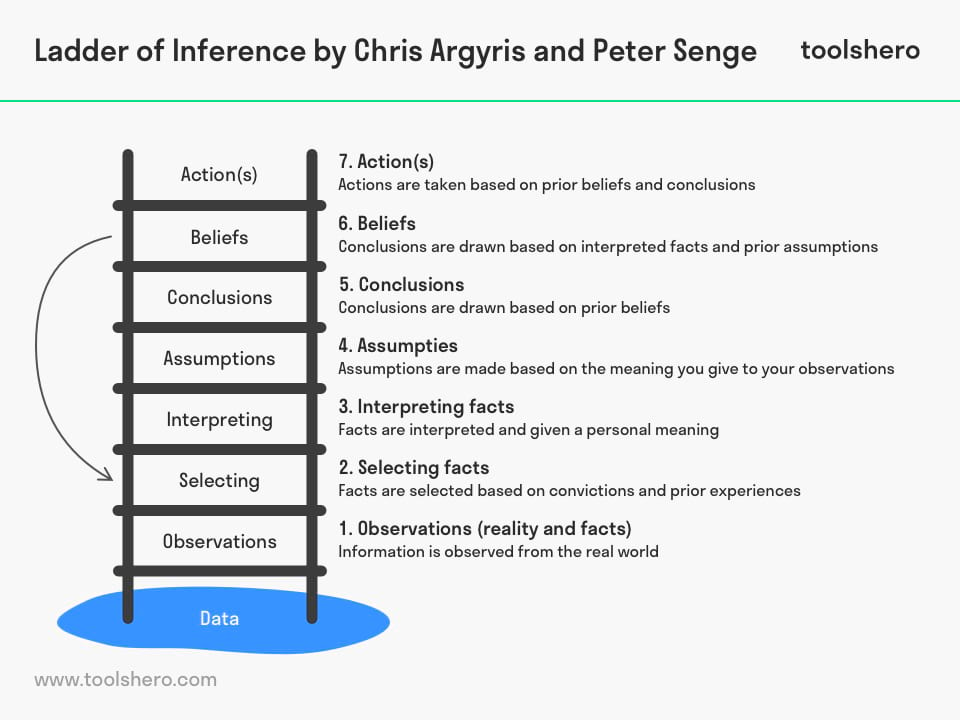Ladder of Inference Model by Chris Argyris and Peter Senge

Ladder of Inference model: this article explains the Ladder of Inference model by Chris Argyris and Peter Senge in a practical way. The article begins with the definition of the Ladder of Inference, followed by a short paragraph about its origin. Then the seven steps or rungs are explained, and the article ends with some practical tips to apply this model in your life. Enjoy reading!
What is the Ladder of Inferenc modele?
People are often lead by jumping to conclusions. These can be correct, but also wrong conclusions and can lead to conflicts with other people. The Ladder of Inference can help you to no longer jump to premature conclusions and to reason on the basis of facts.
Who came up with the ladder of Inference model?
This so-called Ladder of Inference was developed by the American Chris Argyris, a former professor at Harvard Business School, in 1970.
In 1992, The Ladder of Inference became popular after being described in the bestseller The fifth discipline, which Argyris wrote in collaboration with the American scientist Peter M. Senge.
Ladder of Inference vs. Unconscious
The Ladder of Inference provides insight into the mental processes that occur within the human brain.
It describes the perception starting from senses to the series of mental steps that need to be taken to work towards an action. This human thought process only takes a fraction of a second. That is why people do not realise how they developed a certain action or response; it is done unconsciously.
The Ladder of Inference shows how mental models are formed unconsciously. They determine what and how you see and how your thought process and behaviour is led. Every person gives meaning to observations and bases their actions on them.
Ladder of Inference model
The Ladder of Inference model consists of seven rungs or steps and the reasoning process starts at the bottom of the ladder.
People select facts from events, which they translate from prior experiences. These interpreted facts form the basis for assumptions, which in turn lead to certain conclusions. Then a person proceeds to (inter)act. All the rungs of the ladder are described below, starting from the bottom level:

Figure 1 – The Ladder of Inference by Argyris and Senge
1. Reality and facts
This level identifies what is directly perceptible. You observe all information and data from the real world and pay attention. Observable data is the most important factor in this step.
2. Selecting facts
From this level, we select data and facts based on convictions and prior experiences. The frame of reference plays a role in this.
3. Interpreting facts
The facts and data are interpreted and given a personal meaning.
4. Assumptions
At this level, assumptions are made based on the meaning you give to your observations. These assumptions are personal and are different for every individual.
5. Conclusions
At this level, conclusions are drawn based on prior beliefs. Avoid jumping to conclusions in previous steps.
6. Beliefs
At this level, conclusions are drawn based on interpreted facts and prior assumptions, also called existing beliefs.
7. Actions
This is the highest level. Finally we take action based on prior beliefs and conclusions. The actions that are taken seem to be the best at that particular moment.
Ladder of Inference: vicious circle
The processes in The Ladder of Inference often occur unconsciously and in less than a second in the human brain. They happen imperceptibly fast. All the convictions that someone forms influence the next time a situation is perceived. The process continues to repeat itself, and creates a vicious circle, or reflexive loop.
All of the conclusions reinforce the prior beliefs, which in turn influence the selection of facts. This can lead us to ignore certain facts altogether and jump to conclusions.
The Ladder of Inference teaches you to take a few steps back in the reasoning process, allowing you to remain objective and not to immediately jump to conclusions.
How can you use the Ladder of inference to help you deal with unconscious bias?
Using The Ladder of Inference teaches you to look at facts unbiased and not to judge too soon. It is a way to use your own convictions and experiences in a positive manner. The Ladder of Inference can be used in the three following ways:
- Becoming aware of your own thoughts and reasoning.
- Make clear to others how your own reasoning process works. This will allow others to have a better understanding of someone’s motives.
- Research the thought process of other people, by actively asking them about it.
The Ladder of Inference can be used in every stage of the thought process. Anyone can train him/ herself to do so by for example asking the following questions:
- Am I drawing the right conclusion?
- Why did I assume this?
- Is my conclusion based on facts?
- Why do I think this is the right thing to do?
- Can I do this in a different way?
It is also useful to identify the level of the ladder you are currently on. Sometimes it is smart to go back to a lower step. By asking yourself what you are thinking and why at each step, you will be able to analyse each step and no longer jump to premature conclusions.
It’s Your Turn
What do you think? Have you ever heard of the different steps within the Ladder of Inference Model? Do you understand how the ladder works and do you recognize the practical explanation or do you have more suggestions? What are your success factors for good decision making?
Share your experience and knowledge in the comments box below.
More information
- Argyris, C. (1982). The executive mind and double-loop learning. Organizational dynamics, 11(2), 5-22.
- Senge, P. M. (2014). The fifth discipline fieldbook: Strategies and tools for building a learning organization. Crown Business.
- Tompkins, T. C. & Rhodes, K. (2012). Groupthink and the ladder of inference: Increasing effective decision making. The Journal of Human Resource and Adult Learning, 8(2), 84.
How to cite this article:
Mulder, P. (2018). Ladder of Inference Model (Argyris and Senge). Retrieved [insert date] from Toolshero: https://www.toolshero.com/decision-making/ladder-of-inference/
Original publication date: 04/12/2018 | Last update: 03/25/2024
Add a link to this page on your website:
<a href=”https://www.toolshero.com/decision-making/ladder-of-inference/”>Toolshero: Ladder of Inference Model (Argyris and Senge)</a>













10 responses to “Ladder of Inference Model by Chris Argyris and Peter Senge”
Hello Patty, I really liked your article. It is as objective as intelligent. It’s been helpful for me. Congratulations! Thank you very much.
Thank you for your comment, Francisco.
Hello. I appreciate the way you have explained the Ladder of Inference. I have taught this to my 9 and 10 year-old students and am now developing ways to teach this to adults through gaming and other mobile learning methods. I will be sure and cite your article if used. Cheers!
Thank you for your comment, Shirley.
Hello Shirley. I’m curious to learn about your teaching methods with adults. I’m also trying to figure a way to use some type of gaming and/or mobile method. Have you found any to be successful?
I concur with all the above comments! Will ToolsHero give me permission, please? I intend to include the Inference Ladder image in my dissertation study. It is a necessary part of my discussion on Mental Models Theory and how bias can be avoided in the Reflective Research Methodology.
Thank you and I hope to hear back from you.
Best regards,
Myrene
Ah. I will just create my own model but will probably cite some ideas from the article. Thanks!
Myrene
Hi Myrene, thank you for your comment. You can use our article incl. image for your dissertation study if you make a refer / citation to this article. If you have any other questions or comments, please let us know. Kind Regards, Vincent
Oh, thank you so much!!!! I just tweeted your article without even seeing this. Much appreciated!!!!
Myrene
Thank you for your comment, Myrene.